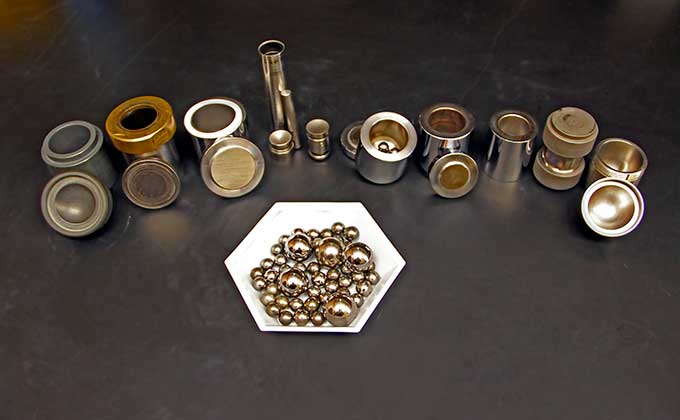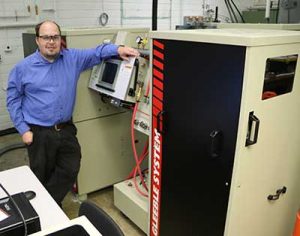This feature story was published by Ames Laboratory. Read the original story here.
Creating materials in their solid state can be tricky, but offers some advantages over other methods. It typically involves subjecting the component elements to some type of mechanical force—such as stress, shear or strain—to drive a reaction.
“You eliminate the need for solvents, so it removes potentially harmful substances from the waste stream,” said Ames Laboratory scientist and Iowa State University Distinguished Professor Vitalij Pecharsky, “and it offers greater selectivity so you can steer it toward a specific reaction. Most processing is done at room temperature so energy inputs are reduced and the resulting end products may be meta-stable as well.”
It also offers a pathway to materials that aren’t typically possible by other methods. One example is the work Pecharsky has done using ball milling. Using this mechano-chemistry technique, you can create a homogeneous mixture—a consistent blend throughout the entire sample—even though you start with a mixture of components that can be 99.9 percent of one component and only 0.1 percent of the second component.
“You can get complete dispersion,” Pecharsky said, “something that would be very difficult to achieve by melting the two components together.”
Because it doesn’t require solvents and often can be done without heat and with relatively low energy inputs, solid-state processing costs less than other methods. In many cases, it’s also scalable to industrial/ commercial applications.

Mechano-Chemical Ball Milling
As the name implies, ball milling uses metal balls in a closed canister to shake, rattle and roll a chemical reaction that turns individual chemical components into a compound. Pecharsky said the impact of the balls with the container and each other, with the material mixture getting smashed between them, transfers the mechanical energy of the rattling balls into chemical energy that in turns drives the reaction.
The shear, stress and strain fractures the normal molecular structure of the component materials, allowing them to combine in ways that normally require a solvent to break the molecular bonds and let the reaction take place.
Pecharsky’s group is using the technique to investigate creation of metal hydrides to serve as a hydrogen storage medium. The group recently added a low temperature ball mill that allows processing of materials that are plastic or ductile.
“These materials will deform, but don’t fracture at room temperature,” Pecharsky said. “By lowering the temperature to that of a liquid nitrogen bath, like most things, they become brittle and we’re able to process them using this technique as well.”
Friction Consolidation
A brand new area for Ames Laboratory, friction consolidation uses high pressure and friction to grind, tear and press new materials into existence.
“It’s very fundamental,” said Ames Laboratory scientist and ISU associate professor of materials science Jun Cui. “We put material in a die and apply pressure with a rotating plunger. The friction from the rotating plunger creates shear stresses within the materials. They eventually heat up, soften and flow homogeneously. It’s a violent and chaotic process, but there’s also a certain amount of order to it.”
The process typically uses powdered metals which are easily consolidated because of the small initial size of the particles. Similar to ball milling, friction consolidation allows creation of microstructures not possible by other means. “For example, you can take copper and process it with carbon nanotubes and wind up with a nanocomposite material that has greater mechanical strength than normal copper without any reduction in electrical conductivity, ” Cui said, “or may create a magnesium-titanium alloy that is corrosion resistant.”
Once the material has been consolidated, it can then be extruded or processed by a number of standard industrial methods.
Gleeble Thermomechanical System
Another new technology for Ames Laboratory is a Gleeble system that allows laboratory simulation of any number of commercial materials processing techniques. The new equipment recently installed in the Laboratory’s Metals Development building lets researchers precisely control and measure what happens to materials during an array of industrial processes from casting and forging to sintering and extrusion.
“It a llows us to do the precise measuring and monitoring of physical simulations of complex processes,” said Pete Collins, Ames Laboratory associate scientist and Iowa State University associate professor of Materials Science and Engineering, “as opposed to computational simulations. However, the two really go hand in hand —our measurements can validate and inform modeling simulations, and modeling can suggest the physical simulations we need to run.”
llows us to do the precise measuring and monitoring of physical simulations of complex processes,” said Pete Collins, Ames Laboratory associate scientist and Iowa State University associate professor of Materials Science and Engineering, “as opposed to computational simulations. However, the two really go hand in hand —our measurements can validate and inform modeling simulations, and modeling can suggest the physical simulations we need to run.”
The equipment uses resistive heating to bring samples quickly to high temperatures needed to simulate melting, casting and welding—thousands of degrees in a few seconds. The electrical demands—enough power to run two or more average homes—were a primary reason for locating the equipment at Ames Laboratory. The equipment was part of Collins’ research startup agreement when he accepted the faculty position at Iowa State.
“It also made sense from a materials processing standpoint to have it located near the (Laboratory’s) other additive manufacturing tools, such as the LENS™ (laser engineered net shaping) 3D printer,” Collins said. “The Gleeble can be an important component of a high throughput suite of capabilities, so we can rapidly test the array of alloy samples that the LENS™ system can produce. In addition, we now have the capability to assess other powder consolidation techniques. We can also take metals powders and simulate how those powders are processed under pressure and temperature to optimize the conditions for the best results.”
Ames Laboratory is a U.S. Department of Energy Office of Science national laboratory operated by Iowa State University. Ames Laboratory creates innovative materials, technologies and energy solutions. We use our expertise, unique capabilities and interdisciplinary collaborations to solve global problems.
DOE’s Office of Science is the single largest supporter of basic research in the physical sciences in the United States, and is working to address some of the most pressing challenges of our time. For more information, please visit science.energy.gov.